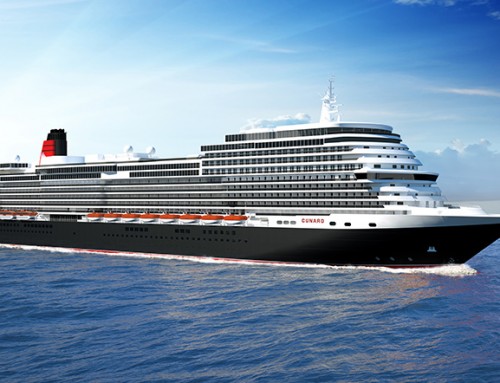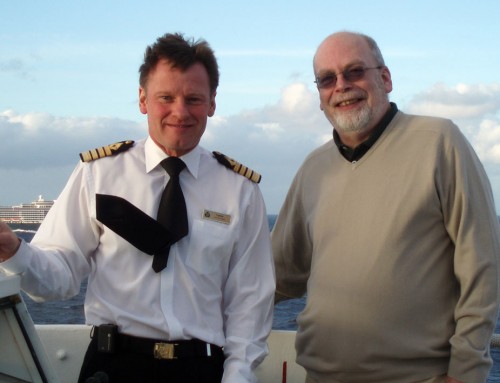The dust has settled on the week’s two big announcements. It’s time to reflect on Britannia and Oasis 3, the two new cruise ships that will respectively become the biggest designed and built built for British passengers, and the biggest in the world.
First, P&O’s Britannia: we knew it would be arriving in 2015, and we knew it was being built on the same basic hull design as this year’s star newcomer, Royal Princess.
The big reveal was the name. Apart from a few generalisations, and the clues to be gained from examining the computer-drawn impressions, we are not much wiser.
It will, according to Carnival UK ceo David Dingle, be “a modern classic, a ship for this and future generations offering authentic travel by sea in an enduringly contemporary setting.”
Sounds good, but it doesn’t really tell us anything.
So, the facts and figures: It will be 141,000 gross register tons – and that, by the way, is not a measure of weight but of volume. Roughly speaking, 100 cubic feet of internal space is equivalent to 1 GRT.
That makes Britannia 21.5 per cent bigger than Azura and Ventura, until now P&O’s biggest ships. Its passenger capacity will be 3,600, an increase of 16 per cent – so each passenger on the new ship will have a little more breathing space.
Judging by the experience of Royal Princess, that extra room is more likely to be found in the public rooms – bars, theatres, restaurants and spa – than in the cabins, which have compact bathrooms and narrow balconies.
In keeping with Dingle’s promise to “attract thousands of newcomers and also resonate with existing passengers” it will include familiar P&O features such as a forward-facing Crow’s Nest bar – not actually present on Azura or Ventura. From the computer drawings, it looks like the bar will be on Lido Deck 16, space which is occupied by cabins on Princess.
The most immediate external design difference between P&O and Princess is the fact that “our” ship has two buff-coloured funnels instead of one. The SeaWalk and SeaView bars which project over the sides of Royal do not feature on Britannia, and nor do the sculpted cabin balconies beneath them, which are overlooked from above and also left in the shade.
That change leaves the new vessel’s flanks looking decidedly like a large apartment block, with seven decks of cabins spreading uninterrupted and unembellished for almost 1,000 feet. Impressive, but not necessarily inspiring.
Dingle boasted that the ship will have the largest spa in P&O’s fleet, but I doubt it will emulate Royal Princess’s cavernous casino and it will be particularly interesting to see if the Live TV studio concept will be tailored for a UK audience.
British preferences will be catered for by a record number of single cabins, according to Dingle, and I hope that the designers learn from early experience of Royal Princess and make sure there is a midships staircase for public use. The absence of this essential facility for the accommodation decks between 8 and 16 makes it more awkward to get around the vessel, necessitating a long wait for a lift or an extended walk along the corridors to the front or aft stairways.
Regular P&O passengers will struggle to get used to the absence of a walk-round Promenade, and the fact that open space at this level on Deck 7 is limited to relatively small spaces midships and aft. Sadly, I doubt this is something that could be remedied at the stroke of a designer’s pencil.
More details and features of the ship will be released in a carefully orchestrated series of announcements over the next 18 months as the excitement builds to its launch in Southampton in spring 2015.
Mr Dingle and his cohorts have one more troubling problem to address: how to match the excitement and publicity generated by Princess’s choice of Kate Middleton, Duchess of Cambridge, as godmother for their ship. An inspired decision, and one which garnered incalculable extra publicity simply by being her last solo public appearance before the birth of Prince George.
They haven’t even started to think about a godmother for Royal Caribbean’s Oasis 3, which I saw this week at the earliest stage of its construction – the cutting of the first piece of steel at STX Europe’s shipyard in Saint-Nazaire, France.
We know this will become the biggest cruise ship in the world, due to enter service in summer 2016, but Royal Caribbean are saying very little more. The builders, however, issued a helpful fact sheet that disclosed significant differences with predecessors Oasis and Allure of the Seas.
Oasis 3 – it could be another 12 months before the real name is announced – will be seven feet longer and carry 88 more passengers when each cabin is occupied by two people. In reality, with third and fourth berths available on bed-settees and pull-down bunks, the ship’s maximum passenger capacity is a staggering 6,360 (compared to 6,318). Add on a potential total of 2,100 crew and that’s a substantial floating community.
That all-important gross register tonnage: 277,700 for Oasis 3 compared with 225,282 for Allure.
Oasis 3 – or Hull No. A34 as the shipyard refers to it – will undoubtedly have the signature Central Park introduced to the seas for the first time by Oasis in 2009. It will copy many other features from its older sisters and there will be some new ones – but we’ll have to wait for that choreographed PR campaign to find out what they are.
It will, according to shipyard chief executive Laurent Castaing, have a unique “French touch” (the earlier versions were built in Finland). And it will, according to Royal Caribbean chairman Richard Fain, be the most energy-efficient cruise ship in the world.
In that case, if you’re still looking for a name, Richard, how about “Saviour of the Seas”?
BRITANNIA PICTURE GALLERY





John Honeywell is a little out-of-date in his explanation of gross tonnage. Since the adoption of the 1969 International Tonnage Convention, ships’ gross tonnage is calculated on a different basis (still a measure of volume) and there is now no such thing as gross register tonnage (grt), – it is just gross tonnage (gt).
Very patriotic etc etc. but shame the national flag in promotional videos is upside down (should the broad white band be at the top on the fixed end of the flag not the free end)sign of distress, bad omen for future or are P&O trying to tell us something!!
Very patriotic etc. But Union Flag is up wrong way!! Broad White band at top on fixed end of flag!! sign of distress wrong way up so what are P&O trying to tell us?
Shame P&O are sending a distress signal by having union flag up wrong way (broad White at top on fixed end of flag.